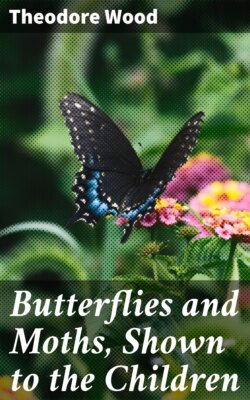Читать книгу Butterflies and Moths, Shown to the Children - Theodore Wood - Страница 9
На сайте Литреса книга снята с продажи.
ОглавлениеPLATE V
1. Speckled Wood
2. Wall
PLATE V
THE SPECKLED WOOD (1)
Table of Contents
As you walk through a wood on a bright sunny day at the end of April, or in the beginning of May, you may often see a dark brown butterfly marked with a number of paler spots, which flits along just in front of you for some little distance, and then mounts up over your head and flies back the way it came. This is a Speckled Wood butterfly, or Wood Argus, as it is sometimes called. Argus, as perhaps you know, was a heathen god, who was supposed to have a hundred eyes. And his name has been given to the butterfly on account of the row of eye-like spots which runs along the margin of the hinder wings.
The caterpillar of this butterfly, which is a pretty little green creature with a white stripe along each side, and a dark brown one along its back, feeds on different kinds of grass, first in August and September, and then again in March. Before it enters into its long winter sleep it throws off its skin no less than five times and appears in a new one, which has been forming underneath the old coat. And, strange to say, it always eats its own cast skins! The chrysalis is of a beautiful bright green colour, and you may sometimes find it fastened to grass blades growing beneath trees in woods.
PLATE V
THE WALL BUTTERFLY (2)
Table of Contents
I think that you must know this butterfly very well indeed by sight, for it is extremely common in all parts of the country. Indeed in May, and again in August, you can hardly walk along a lane, or through a grassy meadow, without seeing it in dozens whenever the sun is shining. It is called the “Wall” butterfly because it is very fond of resting for a moment or two on the top of a roadside wall. But it seems to have very sharp eyes, for if you walk towards the butterfly it is almost sure to fly swiftly away, only to return to the same spot as soon as you have passed by.
Like that of the “speckled wood,” the caterpillar of this butterfly is green in colour, and feeds upon different kinds of grasses. But you can always tell it by the fact that it has three pale lines running along its back instead of one dark brown streak, as well as a rather broader one along each side. The chrysalis is bright apple-green, with a few yellowish-white spots, and you may sometimes find it suspended by its tail from a blade of grass.
